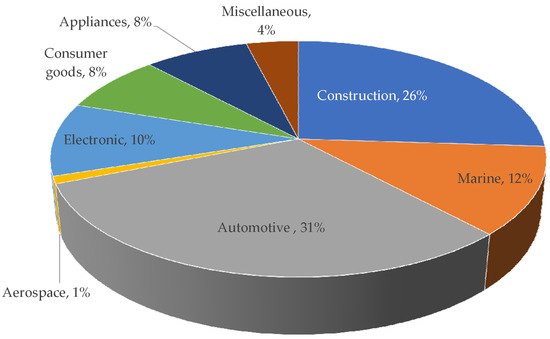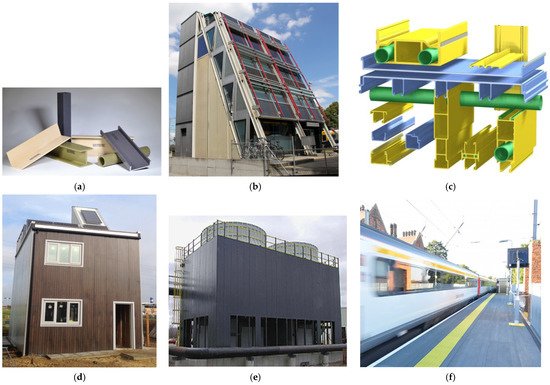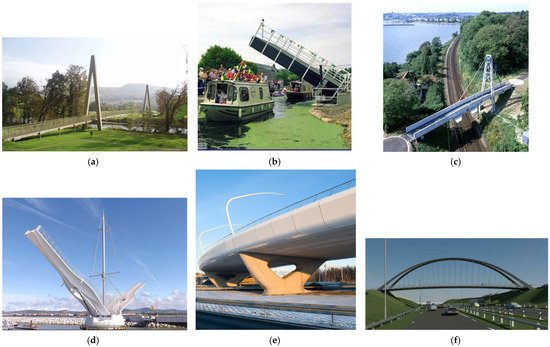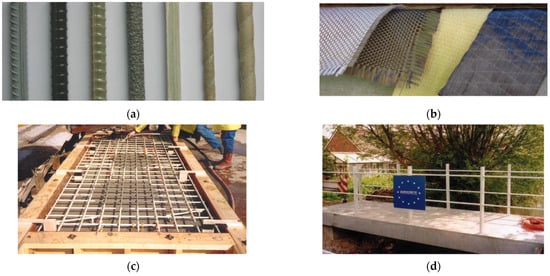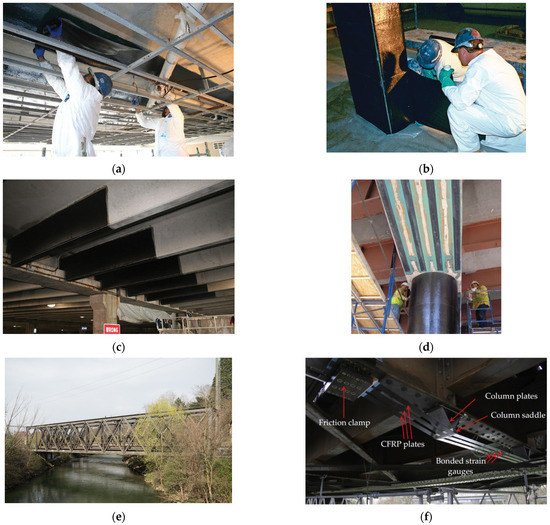Three FRP shapes are used in Structural Engineering applications: FRP profiles for new construction, FRP rebars and FRP strengthening systems. Applications in bridges, buildings, railway platforms, cooling towers and repair and rehabilitation of existing structures are presented. FRP is a strong and lightweight sustainable material with lower carbon footprint than traditional materials. However, FRPs are not as widely used as expected. FRP use in repair and rehabilitation has seen significant growth, though, over last two decades. The major challenges have been steel-like FRP elements, lack of ductility, almost no legal design guidelines and inadequate knowledge about fire and durability performance. The future of FRPs can be promising if engineers use this material more for net-zero carbon construction, and to effectively deal with climate emergency.
1. Introduction
Masonry, timber, steel and concrete are traditional materials that have been used in construction for the last 100 years. Fibre Reinforced Polymer (FRP) is a relatively new material, which has been used in buildings and bridges for over 50 years. FRP use in marine, automotive and aerospace industries dates back to the 1930s
[1][2][1,2]; it has also been used in rail, sport, and wind turbines. Construction uses about a quarter of globally produced FRPs
[3][4][5][3,4,5].
Figure 1 shows the market share of FRPs by applications. FRP composites have fibres encased in a polymer resin. For structural use, glass, carbon, or aramid fibres are usually embedded in polyester, vinylester or epoxy resins. The fibres give strength and stiffness, whilst the resin glues the fibres together; it also protects the fibres and transfers forces between them
[1][2][1,2].
Figure 1. Market share of Fibre Reinforced Polymer (FRP) by application [4][5]. Market share of Fibre Reinforced Polymer (FRP) by application [4,5].
Lightweight, high strength, corrosion resistance and expected durability over their lifetime are the key benefits of FRPs
[6][7][8][6,7,8]. Glass or carbon fibre reinforced polymer (GFRP or CFRP) shapes are used in structural applications. GFRP is more common due to its electrical insulation and electromagnetic transparency, whereas CFRP is electro-conductive
[9]. GFRP is also less energy intensive to produce than CFRP. FRPs generally have linear-elastic stress–strain behaviour up to failure. This is described as a brittle failure, a type of sudden failure without enough warning. Due to brittle nature of FRPs, concepts of stress redistribution and plasticity are often discarded
[10]. FRPs also have relatively poor transverse or shear strength
[11]. There are also concerns about behaviour of FRP at elevated temperatures and exposure to fire
[6]. There are three types of FRPs in Civil Engineering: (1) All-FRP structures for new-build; (2) FRP rebars; (3) FRP strengthening systems. This paper reviews the applications, materials, and manufacturing. The focus is on all-FRP structures, especially their connections and joints.
There is a good amount of research on members in all-FRP structures. The challenge lies in dealing with the connections and joints for FRP members. FRP joint details are currently copied from steel design practice, which mostly leads to oversized FRP components. Due to no plastic redistribution, stress concentrations around bolt holes are higher than ductile streel material, whilst anisotropy and low transverse properties of FRPs add yet more complexity
[1]. Whilst there are no agreed design codes for all-FRP structures, there are design guides though and manufacturers’ manuals
[9][12][13][14][15][16][17][9,12,13,14,15,16,17]; however, they have no legal standing. The designers usually rely on the design guides produced by manufacturers. FRP is a heterogenous material, which has lengthwise strength comparable with structural steel and transverse strength about a third of the longitudinal value. However, the material capacity of FRPs is rarely utilised, as the design is often controlled by deflections rather than strength.
Joints between FRP members can be bolted, bonded or hybrid—combining bolting and bonding
[7]. Bolted joints are useful for demountable structures, but bolt holes create stress concentrations due to discontinuity of fibres and can lead to moisture ingress
[18]. Adhesively bonded joints use the maximum strength and stiffness of fibres without disturbing fibres, but they result in sudden failure and are affected by humidity and high temperatures
[10]. Manufacturers
[9][12][13][9,12,13] recommend using bolted or hybrid joints, and discourage use of adhesive bonding alone. Combining bolting and bonding may not be needed, as the load is mainly taken by the adhesive due to stiff load path, but there are benefits of hybrid joints in some situations. Adhesive bonding is good at taking shear loads, while bolting is the best at transferring direct tension and transverse loads. Fatigue life and fire performance of hybrid joints is better than bolted or bonded joints alone. Hybrid joints resist load in all directions too; they can be used in high temperature environment, if the extra cost of fabrication is justified
[19][20][21][22][19,20,21,22].
2. FRP Applications
2.1. All-FRP New-Build Structurs
All-FRP new-build structures mainly use pultruded fibre reinforced shapes. Pultrusion is an automatic process for producing constant section profiles on a mass scale. The FRP shapes look like structural steel sections but behave similarly to wood
[23]. The standard profiles are produced as I, H, C, leg-angle and tubular sections, see
Figure 2a. FRP elements have been used in building systems, bridges, cooling towers, chemical and food processing plants, railway platforms and marine structures
[7][8][7,8,24,25,26,27] The first mobile five-storey FRP building Eyecatcher (
Figure 2b) was exhibited in 1999 at Swiss Building Fair. Later, it was relocated to another location in Basel, where it still exists as an office building. The building had three adhesively bonded parallel frames with wooden decks. Bolted joints were only used where needed for dismantling
[23][24][23,28].
Figure 2. Applications of FRP in buildings and other structures: (
a) Glass fibre reinforced polymer structural shapes
[12]; (
b) Five-storey Eyecatcher FRP demountable building Switzerland [28]; (
c) Startlink test house modular pultruded FRP concept profiles [29]; (
d) Startlink—Fully composite test house
[25][30]; (
e) Pultruded FRP cooling tower
[12]; (
f) Duracomposites railway platforms
[26][31].
Startlink Lightweight Building System (SLBS) was introduced in the UK in 2012, resulting in construction of a pultruded FRP test house at the developer’s site in Bourne, Lincolnshire, UK. The prototype/concept modular FRP profiles are shown in
Figure 2c. However, these concept profiles and their snap-fit connections were not pursued further. Much simpler and fewer pultruded FRP profiles, with easy to assemble connections, were used in the construction of the actual test house. This all-FRP test house was supported on composite piles; and it was built just in two weeks
[27][25][29,30], see
Figure 2d. The Startlink test house does not exist anymore. It has been taken down; and the author is not aware if it has been constructed anywhere else in the UK.
FRPs are also used in cooling tower industry. Cooling towers are used for heating, cooling, ventilation and industrial purposes. GFRP profiles can resist corrosion and exposure to water often encountered in cooling towers. Manufactures
[9][12][9,12] supply bespoke and standard FRP elements for cooling towers, see
Figure 2e. GFRP railway platforms are also becoming popular due to speed of construction and ease of assembly
[9][13][26][9,13,31], see
Figure 2f. FRP composites are also used in secondary structures; these include insulated ladders, floor gratings, stairways with handrails, working platforms and walkways and building façade panels
[1]. Bridge engineering applications of FRP are presented in
Figure 3 and are discussed next.
Figure 3. Applications of FRP in bridges: (
a) Aberfeldy Scotland footbridge
[28][32]; (
b) Bonds Mill lifting bridge
[29][33]; (
c) Kolding Denmark FRP pedestrian bridge, 1997
[9][30][9,34]; (
d) The Pont y Ddraig, the Dragon bascule bridge in Wales, 2013
[31][35]; (
e) Fly-over Waarderpolder bridge in Netherland with FRP edge elements
[32][36]; (
f) Emersons Green Cycle Footbridge, Bristol UK
[33][37].
Corrosion and fatigue resistance, high strength-to-weight ratio and formability are some of the desirable properties of FRP for bridges
[3][34][3,38]. FRPs have been used to repair, replace, or retrofit existing steel or concrete bridges. FRP is used in new footbridge and highway bridges. Critical elements in bridges are generally hybrids-FRP and traditional materials. Global developments in FRP bridges are reviewed in a recent paper
[3]. FRP bridges in the UK are reviewed in
[35][39], the US in
[36][37][40,41] and the Netherlands in
[32][36]. FRP bridges are fabricated using standard or bespoke FRP elements
[38][42]. Aberfeldy, Scotland cable stayed bridge was the first major FRP composite footbridge completed in 1992. The 113 m long bridge had pultruded GFRP composite deck supported by aramid cables attached to GFRP A-frames. It carried pedestrians and golf buggies on a golf course, see
Figure 3a. Only foundations were constructed from concrete
[29][35][38][33,39,42].
The first ever FRP road bridge is the Bonds Mill Lift bridge near Gloucester, UK (
Figure 3b); it was constructed over a canal in 1994. The bridge had a multi-cellular box girder filled with structural foam to resist local bending from wheel loads
[15][29][15,33,39,
[38]42]. The lightweight bridge elements helped in mechanical lifting system
[38][42]. The first FRP composite bridge in the USA was constructed over no-name Creek, Kensas in 1996. The bridge used decks with glass FRP laminated skin and corrugated core
[15]. Similarly, in Kolding, Denmark, an all-FRP cable stayed footbridge was constructed in 1997, see
Figure 3c. It was the first FRP bridge over a busy railway line in Europe. The bridge girders and pylons were pultruded GFRP. Only bolts and abutments were stainless steel
[30][34]. In 2011, a new all-FRP bridge was constructed at Dawlish rail station in Exeter, UK to replace a rusty steel bridge. The new FRP bridge mimicked the shape of the old steel bridge, see
Figure 4. The new FRP bridge survived 2014 storms; it remained undamaged and corrosion free
[39][40][43,44].
Figure 4.
Dawlish pedestrian bridge Exeter UK: (
a) Old rusty steel bridge, 1937 [40]; ( ) Old rusty steel bridge, 1937 [44]; ( b) New FRP bridge, 2011 [40]. ) New FRP bridge, 2011 [44].
The best example of combining carbon and glass FRPs is the Pont y Ddraig or the Dragons bridge (
Figure 3d) at Rhyl Harbour, North Wales, built in 2013. This double bascule footbridge uses the freedom in geometry and lightweight of FRP materials. It had two mirroring, 32 m long decks hinged on a central caisson. The decks can be lifted for navigation by cables running up to a central stainless steel tower. They are made from resin-infused FRPs
[15][31][15,35]. FRP edge elements were used in the fly-over Waarderpolder in Haarlem, Netherlands (
Figure 3e). Use of FRP edge elements removes durability concerns inherent to steel and concrete edge elements, and give more freedom and choice in geometry
[32][36]; moreover, the FRP edge elements are also aesthetically pleasing. The proposed Emersons Green East FRP cycle footbridge will be constructed in Bristol, UK, see
Figure 3f. The bridge will have carbon fibre reinforced polymer (CFRP) arch ribs that will support glass fibre reinforced polymer (GFRP) deck. Structural health monitoring equipment will also be installed on the bridge for research
[33][37].
2.2. FRP as Reinforcement
FRP reinforcements have been used in structural engineering since 1950s. Today, FRP rebars, grids, fabrics, strips, prestressing tendons, and formwork are commercially available
[2][41][2,45]. FRP reinforcements are suitable in aggressive conditions, such as alkaline, corrosive and chemical environments. Lightweight and electromagnetic neutrality are other benefits of FRP rebars, especially glass FRPs. Carbon, glass, aramid fibre reinforced polymer bars are commonly used. Research in FRP reinforcement is quite developed compared to all-FRP pultruded structures. Several design guides for FRP rebars are available too. In Europe, the task group 5.1 (formerly 9.3) produced technical report fib 40
[41][45] for FRP reinforcement in concrete structures. Also, The Concrete Society has its TR55
[42][46] design guide for strengthening applications including FRP rebars
[43][47]. In the USA, ACI 440.1R-15
[44][48] deals with design of concrete members with FRP bars. FRP reinforcements and their applications are shown in
Figure 5. Design of bridge beams prestressed with CFRP bars or cables is given in NCHRP research report 907
[45][49].
2.3. FRP in Strengthening Applications
Research, design and practice are well advanced for FRP use as strengthening material. FRP can be used for repair and strengthening of existing structures. Externally bonded reinforcements can be used to reinforce concrete, timber, steel and masonry structures
[46][50]. Design guidelines for externally bonded FRP systems concrete structures are available in Europe (CEB-FIP fib bulletin 14
[47][51]) and America (ACI 440.2R-17
[48][52]). Various other guidelines have also been produced in USA, Japan and Italy
[49][50][51][52][53][54][55][56][57][53,54,55,56,57,58,59,60,61] for FRP strengthening applications. Different design guides for FRP strengthening are compared in
[58][62]. Environmental actions, poor design, lack of maintenance or accidental events cause deterioration to existing structures
[47][51]. Strengthening of these structures with FRP systems not only restores them, but enhances their strength, too. FRP for strengthening is available as strips, sheets and fabrics.
Figure 5. FRP as a reinforcement: (
a) FRP rebars
[41][59][45,63]; (
b) FRP fabrics
[59][63]; (
c) FRP bars in 1995 Fidgett Footbridge Chalgrove-Oxfordshire, UK
[59][63]; (
d) Completed Fidgett Footbridge
[59][63].
FRP strengthening can be applied in-situ using hand layup or can be prefabricated off-site in a factory. Hand or wet layup consists of applying epoxy resin to woven fabric sheets or flexible fibre sheets to produce FRP sheets bonded to concrete members. The prefabrication method involves pultrusion for FRP plates bonded to beams and slabs or filament winding for making FRP shells for confining columns
[64]. Pultrusion and filament [60]winding manufacturing processes are discussed later in Section 3.
FRP strengthening of concrete slabs, columns and beams
[61][65] using FRP sheets is shown in
Figure 6a–c. Flexural strengthening of beams with FRP plates and FRP wrapping of concrete column
[59][63] is presented in
Figure 6d. Next shown in
Figure 6e is the 120 years old Münchenstein Railway Bridge in Switzerland; this is a metallic rivetted bridge. Traditional strengthening solution using steel plates or bonded CFRP plates were discarded due to unsmooth rivetted surfaces. Ghafoori et al.
[62][66] came up with innovative ideas of fatigue strengthening and wireless monitoring for this bridge. They used CFRP unbonded prestressed plates with wireless sensors to strengthen fatigue prone areas of the bridge
[62][66], as shown in
Figure 6f. Other FRP strengthening techniques for bridges are discussed in
[63][67].
Figure 6. FRP in strengthening applications: (
a) Flexural strengthening of slab
[61][65]; (
b) Wrapping FRP fabrics around concrete columns
[61][65]; (
c) CFRP strengthening of beams
[61][65]; (
d) FRP plates bonded to beams
[59][63]; (
e) Münchenstein Railway Bridge (120 years old) Switzerland
[62][66]; (
f) CFRP strengthening of Münchenstein bridge with sensors to monitor long-term prestress level
[62][66].
3. Challenges and future trends
The major
schallenge
tbacks to wider
applicationuse of FRP in Civil Engineering are lack of legal design codes, steel
- like detailing for all-FRP structures
[64][68], lack of ductility, scarce information about fire and durability performance and lack of simplified FRP design books for structural engineers. At present
, some evolving design guides are available: Eurocomp
[17], ASCE Pre-Standard for pultruded FRP
[14], FRP bridges
[15] and
the Italian guide for pultruded FRP elements
[16];[16]. however,But these guides have no legal status. A comparison of these guides is presented elsewhere
[23][69]. The main benefits of FRPs are their high strength, lightweight and corrosion resistance. While in
the repair and rehabilitation market
, FRPs have shown good progress over last three decades, all-FRP structures still need their fair place in construction industry. This will be possible if whole
-life cost of FRP assets is considered
, and legally binding design codes are produced.
4. Conclusions
High strength, lightweight, corrosion resistance and chemical inertness are some of the most desirable properties of FRPs for structural engineering use. FRP composites present a unique opportunity for structural engineers to adopt an environmentally friendly material. With an ecological impact of about a third of traditional materials
[65][70], glass FRP can lead to low carbon construction. The global market for glass FRP is valued at 9.7 billion USD in 2021
[66][71] and it is set to grow in next decade. We are best placed now than ever to exploit the competitive properties of FRP composites.
References
- Correia, J.R. Fibre-Reinforced Polymer (FRP) Composites. In Materials for Construction and Civil Engineering, Science, Processing, and Design; Goncalves, M.C., Margarido, F., Eds.; Springer International Publishing, Switzerland, 2015; pp. 501–556 ISBN 978-3-319-08235-6.
- Bank, L.C. Composites for construction - Structural design with FRP materials; John Wiley & Sons: NJ, USA, 2006;
- Ali, H.T.; Akrami, R.; Fotouhi, S.; Bodaghi, M.; Saeedifar, M.; Yusuf, M.; Fotouhi, M. Fiber reinforced polymer composites in bridge industry. Structures 2021, 30, 774–785, doi:10.1016/j.istruc.2020.12.092.
- Anandjiwala, R.D.; Blouw, S. Composites from Bast Fibres-Prospects and Potential in the Changing Market Environment. J. Nat. Fibers 2007, 4, 91–109, doi:10.1300/J395v04n02_07.
- Duflou, J.R.; Deng, Y.; Van Acker, K.; Dewulf, W. Do fiber-reinforced polymer composites provide environmentally benign alternatives? A life-cycle-assessment-based study. MRS Bull. 2012, 37, 374–382, doi:10.1557/mrs.2012.33.
- Correia, J.R.; Bai, Y.; Keller, T. A review of the fire behaviour of pultruded GFRP structural profiles for civil engineering applications. Compos. Struct. 2015, 127, 267–287, doi:10.1016/j.compstruct.2015.03.006.
- Qureshi, J.; Nadir, Y.; John, S.K. Bolted and bonded FRP beam-column joints with semi-rigid end conditions. Compos. Struct. 2020, 247, 112500, doi:10.1016/j.compstruct.2020.112500.
- Qureshi, J.; Nadir, Y.; John, S.K. Cyclic Response of Bolted and Hybrid Pultruded FRP Beam-Column Joints between I-Shaped Sections. Fibers 2021, 9, doi:10.3390/fib9110066.
- Fiberline Composites Fiberline design manual; Fiberline Composites A/S: Kolding, Denmark, 2002;
- Vallée, T.; Tannert, T.; Meena, R.; Hehl, S. Dimensioning method for bolted, adhesively bonded, and hybrid joints involving Fibre-Reinforced-Polymers. Compos. Part B Eng. 2013, 46, 179–187, doi:10.1016/j.compositesb.2012.09.074.
- Masuelli, M.A. Introduction of Fibre-Reinforced Polymers − Polymers and Composites: Concepts, Properties and Processes. In Fiber Reinforced Polymers The Technology Applied for Concrete Repair; Masuelli, M.A., Ed.; IntechOpen: London, UK, 2013; p. Ch. 1 ISBN 978-953-51-0938-9.
- Strongwell Strongwell design manual; Strongwell Corporation: Bristol, Virginia, USA, 2010;
- Creative Pultrusions The new and improved Pultex pultrusion design manual; Creative Pultrusions Inc.: Alum Bank, PA, USA, 2004;
- ASCE Pre-standard Pre-standard for Load and Resistance Factor Design (LRFD) of pultruded Fiber Reinforced Polymer (FRP) structures (Final); American Composites Manufacturers Association, American Society of Civil Engineers: Reston, VA, USA, 2010;
- Fibre-reinforced polymer bridges – guidance for designers; Mottram, J.T., Henderson, J., Eds.; Composites UK: Construction Sector Group, CIRIA publication C779, London, 2018; ISBN 9780860177944.
- CNR-DT 205/2007 Guide for the design and construction of structures made of FRP pultruded elements, CNR – Advisory Committee on Technical Recommendations for Construction; National Research Council of Italy, 2008;
- Clarke, J.L. Structural Design of Polymer Composites- EUROCOMP Design Code and Handbook; E and FN Spon: London, UK, 1996;
- Ascione, F.; Lamberti, M.; Razaqpur, A.G.; Spadea, S. Strength and stiffness of adhesively bonded GFRP beam-column moment resisting connections. Compos. Struct. 2017, 160, 1248–1257, doi:10.1016/j.compstruct.2016.11.021.
- Kelly, G. Load transfer in hybrid (bonded/bolted) composite single-lap joints. Compos. Struct. 2005, 69, 35–43, doi:10.1016/j.compstruct.2004.04.016.
- Kelly, G. Quasi-static strength and fatigue life of hybrid (bonded/bolted) composite single-lap joints. Compos. Struct. 2006, 72, 119–129, doi:10.1016/j.compstruct.2004.11.002.
- Weitzenböck, J.R.; McGeorge, D. Science and technology of bolt-adhesive joints. Adv. Struct. Mater. 2011, 6, 177–199, doi:10.1007/8611_2011_54.
- Anonymus Guide to the structural use of adhesives; The Institution of Structural Engineers: London, UK, 1999; ISBN 1874266433.
- Keller, T. Towards Structural Forms for Composite Fibre Materials. Struct. Eng. Int. 1999, 9, 297–300, doi:10.2749/101686699780481673.
- Qureshi, J.; Mottram, J.T. Behaviour of pultruded beam-to-column joints using steel web cleats. Thin-Walled Struct. 2013, 73, 48–56, doi:10.1016/j.tws.2013.06.019.
- Qureshi, J.; Mottram, J.T. Response of beam-to-column web cleated joints for FRP pultruded members. J. Compos. Constr. 2014, 18, 04013039, doi:10.1061/(ASCE)CC.1943-5614.0000392.
- Qureshi, J.; Mottram, J.T. Moment-rotation response of nominally pinned beam-to-column joints for frames of pultruded fibre reinforced polymer. Constr. Build. Mater. 2015, 77, 396–403, doi:10.1016/j.conbuildmat.2014.12.057.
- Vedernikov, A.; Safonov, A.; Tucci, F.; Carlone, P.; Akhatov, I. Pultruded materials and structures: A review. J. Compos. Mater. 2020, 54, 4081–4117, doi:10.1177/0021998320922894.
- Keller, T.; Nikolaos, A.T.; Anastasios, P.V.; de Castro, J. Effect of Natural Weathering on Durability of Pultruded Glass Fiber–Reinforced Bridge and Building Structures. J. Compos. Constr. 2016, 20, 4015025, doi:10.1061/(ASCE)CC.1943-5614.0000589.
- Singleton, M.; Hutchinson, J. Development of Fibre-Reinforced Polymer Composites in Building Construction. In Proceedings of the Second International Conference on Sustainable Construction Materials and Technologies; Zachar, J., Claisse, P., Naik, T.R., Ganjian, E., Eds.; Università Politecnica delle Marche: Ancona, Italy, 2010.
- Zafari, B. STARTLINK building system and connections for fibre reinforced polymer structures, PhD Thesis, University of Warwick, Coventry, UK, 2012.
- DuraComposites GFRP Station Platform Available online: https://www.duracomposites.com/rail/grp-composite-station-platforms/ (accessed on Nov 11, 2021).
- Skinner, J.M. A critical analysis of the Aberfeldy footbridge Scotland. In Proceedings of the Bridge Engineering 2 Conference; University of Bath: Bath, UK, 2009.
- Burgoyne, C.J. Advanced Composites in Civil Engineering in Europe. Struct. Eng. Int. 1999, 9, 267–273, doi:10.2749/101686699780481682.
- Braestrup, M.W. Footbridge Constructed from Glass-Fibre-Reinforced Profiles, Denmark. Struct. Eng. Int. 1999, 9, 256–258, doi:10.2749/101686699780481709.
- Hobbs, M. Design and fabrication of two 30 m long moulded FRP decks for the Pont y Ddraig lifting footbridge. In Proceedings of the Second International Conference on the use of Fibre-Reinforced Polymer Composites in Bridge Design; NetComposites: Loondon, UK, 2014.
- Smits, J. Fiber-Reinforced Polymer Bridge Design in the Netherlands: Architectural Challenges toward Innovative, Sustainable, and Durable Bridges. Engineering 2016, 2, 518–527, doi:10.1016/J.ENG.2016.04.004.
- Nepomuceno, D.D.T.; Bennetts, J.; Webb, G.T.; Langhorne, M.; Johnson, M.; Macdonald, J.H.G.; Tryfonas, T.; Vardanega, P.J. Assessing the Potential Value of a SHM Deployment on a Proposed Footbridge. In Proceedings of the Advances and Challenges in Structural Engineering, 2nd GeoMEast International Congress and Exhibition on Sustainable Civil Infrastructures, Egypt; Rodrigues, H., Elnashai, A., Eds.; Springer International Publishing: Cham, 2019; pp. 151–166.
- Keller, T. Overview of fibre-reinforced polymers in bridge construction. Struct. Eng. Int. J. Int. Assoc. Bridg. Struct. Eng. 2002, 12, 66–70, doi:10.2749/101686602777965595.
- Canning, L.; Luke, S. Development of FRP Bridges in the UK — An Overview. Adv. Struct. Eng. 2010, 13, 823–835, doi:10.1260/1369-4332.13.5.823.
- Alampalli, S.; Kunin, J. Load Testing of an FRP Bridge Deck on a Truss Bridge. Appl. Compos. Mater. 2003, 10, 85–102, doi:10.1023/A:1022885728627.
- Bank, L.C. Application of FRP Composites to Bridges in the USA. In Proceedings of the International Colloquium on Application of FRP to Bridges; Japan Society of Civil Engineers (JSCE): Tokyo, JAPAN, 2006; pp. 9–16.
- The International Handbook of FRP Composites in Civil Engineering; Zoghi, M., Ed.; 1st ed.; CRC Press: Abingdon, Oxon, UK, 2013;
- Smale, K. Delivering Differently | Fibre reinforced polymers Available online: https://www.newcivilengineer.com/archive/delivering-differently-fibre-reinforced-polymers-18-01-2016/ (accessed on Nov 11, 2021).
- Kendall, D.; Smith, I.; Young, C.; Gough, W.; Cross, A. Dawlish FRP footbridge – The first FRP bridge at a UK railway station. In Proceedings of the FRP Bridge Conference; NetComposites: London UK, 2012; pp. 101–117.
- CEB-FIP fib bulletin 40 FRP reinforcement in RC structures; International Federation for Structural Concrete (fib): Lausanne, Switzerland, 2007; ISBN 978-2-88394-080-2.
- Concrete Society Technical Report 55 Design guidance for strengthening concrete structures using fibre composite materials; 3rd ed.; The Concrete Society: Crowthorne, UK, 2012;
- Arya, C.; Clarke, J.L.; Kay, E.A.; O’Regan, P.D. TR 55: Design guidance for stengthening concrete structures using fibre composite materials: a review. Eng. Struct. 2002, 24, 889–900, doi:10.1016/S0141-0296(02)00027-5.
- ACI 440.1R-15 Guide for the Design and Construction of Structural Concrete Reinforced with Fiber-Reinforced Polymer (FRP) Bars; American Concrete Institute: Farmington Hills, MI, USA, 2015; ISBN 978-1-942727-10-1.
- NCHRP RESEARCH REPORT 907 Design of Concrete Bridge Beams Prestressed with CFRP Systems; Belarbi, A., Dawood, M., Poudel, P., Reda, M., Tahsiri, H., Gencturk, B., Rizkalla, S.H., Russell, H.G., Eds.; The National Academies Press: Washington, DC, 2019; ISBN 978-0-309-48069-7.
- Mugahed Amran, Y.H.; Alyousef, R.; Rashid, R.S.M.; Alabduljabbar, H.; Hung, C.-C. Properties and applications of FRP in strengthening RC structures: A review. Structures 2018, 16, 208–238, doi:10.1016/j.istruc.2018.09.008.
- CEB-FIP fib bulletin 14 Externally bonded FRP reinforcement for RC structures; International Federation for Structural Concrete (fib): Lausanne, Switzerland, 2001; ISBN 2-88394-054-1.
- ACI 440.2R-17 Guide for the Design and Construction of Externally Bonded FRP Systems for Strengthening Concrete Structures; American Concrete Institute: Farmington Hills, MI, USA, 2017; ISBN 978-1-945487-59-0.
- Machida, A.; Uomoto, T. Recommendation for design and construction of concrete structures using continuous fiber reinforcing materials; Japan Soc. of Civil Engineers, 1997;
- ISIS Design Manual No. 4 FRP Rehabilitation of Reinforced Concrete Structures; ISIS Canada Corporation: Manitoba, Canada, 2008;
- CNR-DT 200 R1/2013 Guide for the Design and Construction of Externally Bonded FRP Systems for Strengthening Existing Structures; Rome, Italy, 2013;
- AASHTO-2013 Guide Specifications for Design of Bonded FRP Systems for Repair and Strengthening of Concrete Bridge Elements; American Association of State Highway and Transportation Officials: Washington, D.C, USA, 2013;
- NCHRP REPORT 514 Bonded Repair and Retrofit of Concrete Structures Using FRP Composites - Recommended Construction Specifications and Process Control Manual; The National Academies Press: Washington, DC, 2003; ISBN 978-0-309-43205-4.
- NCHRP SYNTHESIS 512 Use of Fiber-Reinforced Polymers in Highway Infrastructure; Kim, Y.J., Ed.; The National Academies Press: Washington, DC, 2017; ISBN 978-0-309-39004-0.
- NCHRP REPORT 564 Field Inspection of In-Service FRP Bridge Decks; The National Academies Press: Washington, DC, 2006; ISBN 978-0-309-42533-9.
- NCHRP REPORT 655 Recommended Guide Specification for the Design of Externally Bonded FRP Systems for Repair and Strengthening of Concrete Bridge Elements; The National Academies Press: Washington, DC, 2010; ISBN 978-0-309-15485-7.
- NCHRP REPORT 678 Design of FRP Systems for Strengthening Concrete Girders in Shear; The National Academies Press: Washington, DC, 2011; ISBN 978-0-309-15531-1.
- Wu, H.C.; Eamon, C.D. Strengthening of concrete structures using fiber reinforced polymers (FRP): Design, construction and practical applications; Woodhead Publishing/Elsevier: Duxford, UK, 2017; ISBN 978-0-08-100641-2.
- Guadagnini, M. Use of composite materials in structural applications:a European perspective. In Proceedings of the Second International Conference on the use of Fibre-Reinforced Polymer Composites in Bridge Design; NetComposites: London, UK, 2014.
- Teng, J.G.; Chen, J.F.; Smith, S.T.; Lam, L. Behaviour and strength of FRP-strengthened RC structures: a state-of-the-art review. Proc. Inst. Civ. Eng. - Struct. Build. 2003, 156, 51–62, doi:10.1680/stbu.2003.156.1.51.
- Alkhrdaji, T. Strengthening of Concrete Structures using FRP Composites. Struct. Mag. by Natl. Counc. Struct. Eng. Assoc. 2015, 18–20.
- Ghafoori, E.; Motavalli, M.; Nussbaumer, A.; Herwig, A.; Prinz, G.S.; Fontana, M. Design criterion for fatigue strengthening of riveted beams in a 120-year-old railway metallic bridge using pre-stressed CFRP plates. Compos. Part B Eng. 2015, 68, 1–13, doi:10.1016/j.compositesb.2014.08.026.
- Hu, W.; Li, Y.; Yuan, H. Review of Experimental Studies on Application of FRP for Strengthening of Bridge Structures. Adv. Mater. Sci. Eng. 2020, 2020, doi:10.1155/2020/8682163.
- Burgoyne, C.; Balafas, I. Why is FRP not a financial success? In Proceedings of the 8th International Symposium on Fiber-Reinforced Polymer Reinforcement for Concrete Structures (FRPRCS-8); Triantafillou, T., Ed.; University of Patras: Patras, Greece, 2007.
- Girão Coelho, A.M.; Mottram, J.T. A review of the behaviour and analysis of bolted connections and joints in pultruded fibre reinforced polymers. Mater. Des. 2015, 74, 86–107, doi:10.1016/j.matdes.2015.02.011.
- Kendall, D. Developments in FRP bridge design. Reinf. Plast. 2010, 54, 38–42, doi:10.1016/S0034-3617(10)70111-9.
- Industry Experts Glass Fiber Reinforcements – A Global Market Overview Available online: https://industry-experts.com/verticals/chemicals-and-materials/glass-fiber-reinforcements-a-global-market-overview (accessed on Dec 8, 2021).
